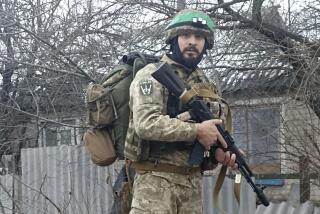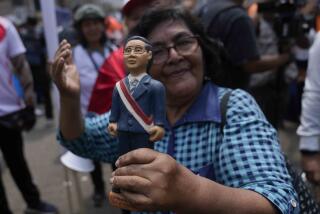Colombia: The South American Country at a Glance
- Share via
The following, at a glance, is a profile of the South American nation of Colombia, where the volcano Nevado del Ruiz erupted late Wednesday night about 100 miles northwest of the capital of Bogota.
GEOGRAPHY--Colombia is bordered on the northwest by Panama, on the north by the Caribbean Sea, on the east by Venezuela and Brazil, on the southwest by Peru and Ecuador, and on the west by the Pacific Ocean.
With 456,500 square miles of territory, it is about three times the size of California.
Three major geological plates converge on the region where Colombia borders Panama: the Nazca plate underlying the Pacific, the American plate beneath the continent, and the Caribbean plate.
A belt of earthquake activity stretches along the borders of the shifting, clashing plates, and volcanoes are frequently associated with such geographical activity.
About 70% of the land is unsettled (mostly forest and savanna); 28% is settled (consisting of 5% crop and fallow; 14% pasture, 6% forest, swamp and water; 3% urban and other).
POPULATION--With more than 29 million inhabitants, Colombia is 95% Roman Catholic. The main ethnic groups are Mestizo, 58%; Caucasian, 20%; Mulatto, 14%; African descent, 4%; mixed black-Indian, 3%; Indian, 1%. The predominant language is Spanish. The literacy rate is 81%. Suffrage at age 18.
HISTORY--Established as the Spanish colony of New Granada in 1549, Colombia proclaimed its independence and formed the Republic of Greater Colombia in 1819. The nation has been one of the few functioning democracies in South America for nearly all of its post-independence history.
POLITICS--The current Conservative Party president, Belisario Betancur, was elected May 30, 1982.
Colombia is battling urban leftist guerrilla groups, of which the April 19th Movement, also known as M-19, is the most aggressive and best-organized. M-19 guerrillas occupied the Palace of Justice in Bogota on Nov. 6-7, killing over 100 people, including 12 Supreme Court justices, before being routed by troops.
In 1957, the Liberal Party and Conservative Party formed the “National Front” under which they jointly governed, alternating the presidency every four years and alloting parity in all elective and appointive offices. Elections are held every four years.
That arrangement ended “La Violencia,” a period of warfare between the parties that killed an estimated 200,000 people from 1948-58. The power-sharing arrangement was phased out during the 1970s.
DEFENSE FORCES--Army, Navy and Air Force. Military manpower: males 14-49, 7,646,000; 5,421,000 fit for military service; about 356,000 reach military age (18) annually.
ECONOMY--The chief crops are coffee, accounting for 50% of all exports, rice, tobacco, cotton, sugar and bananas. Major trade partners are the United States, Venezuela, Italy and Japan. Colombia has crude oil reserves of about 3.2 billions barrels. Mineral resources include gold, copper, lead, coal, iron and nickel. Major industries include textiles, food processing, clothing and footwear. In 1981, per capita income was $1,269 and inflation was 24.7%.
FOREIGN RELATIONS--The government follows a pragmatic approach, seeking friendly diplomatic and commercial relations with all nations. Colombia is a member of the Organization of American States. It was the only Latin American nation to contribute troops to the U.N. force during the Korean War. Colombia has been cooperating with the United States to eradicate marijuana and reduce the flow of illicit drugs smuggled to the United States.
More to Read
Sign up for Essential California
The most important California stories and recommendations in your inbox every morning.
You may occasionally receive promotional content from the Los Angeles Times.













